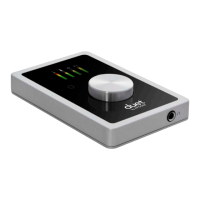Apogee Duet User’s Guide
MIDI
Duet provides a single USB MIDI connection for your CoreMIDI compatible keyboard, synth, or
DJ controller. This eliminates the need for an external MIDI interface and promotes an all-in-one
music creation solution. On iPad, Duet’s MIDI connection allows both Duet and a keyboard or
DJ controller to be connected at the same time to the iPad’s single dock port.
Analog In and Out
This port is for connecting Duet’s breakout cable. The breakout cable includes 2 combination
mic/instrument connectors (XLR and 1/4” built into a single connector) and 2 balanced 1/4”
connectors for speakers. The elegant single cable-to-junction design allows for easy cable
management and the locking connection to Duet is robust and stylish.
DC Power
Duet is easily powered by any available USB port on your Mac in most applications. However
there may be scenarios where connecting the external AC power adaptor is required.
Connection to iOS Devices (iPad, iPhone, iPod touch)
When connected to iPad, iPod Touch, or iPhone, the DC power supply for Duet MUST
be used. Duet will charge your iPad while you record so your work will not be interrupted.
Connection to Mac: Increased Duet Power Consumption Exceeds USB Bandwidth
When connecting to a Mac, Duet can be powered via the USB cable alone. However if
the following message appears, connect DC power to the Duet:
This will appear on the OLED if the external power is necessary with Mac
Here are the circumstances that may trigger this message:
● Output volume into low impedance headphones
● Power-hungry condenser mics are connected.
If you have Duet set at a reasonable output volume and are not drawing a significant amount of
power over the USB bus, you will be able to connect any microphones that require phantom
power. When you are using low impedance headphones and your volume is very high, you are
drawing more power over the USB bus and may need the AC adaptor to use power hungry
condenser mics.
Page 5

